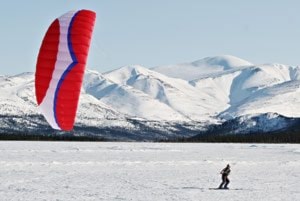Jim Welsh and Catherine McCarthy found a better way to climb hills during their long ski touring expeditions — using wind power.
The pair recently completed an 11-day trek from Juneau to Atlin, crossing the icefields with ease using specially designed snow kites.
“For us, it changed ski touring forever, because the kite is so light and it fits in your pack,” said Jim Welsh. “All of a sudden going uphill became fun.”
Joined by fellow Yukoner Seth Plunket and two Swedish skiers, the group started on the Taku Glacier, followed it to the Mathes, and then came down the Llewelyn Glacier on a carefully considered route.
“It took a tonne of planning; we used Google Earth a lot and Geomatics Yukon,” said Welsh. “It’s a surprisingly small distance, just 110 kilometres.”
They prepared for a windless trip, packing sleds with enough food and supplies for 14 days.
“The first four days we base camped and did a lot of ski touring and there wasn’t a lot of wind,” he said.
When the wind finally picked up, the kites came out of the packs, and the trip shifted into high gear.
“From the fifth day on we had a lot of wind and it was almost too effective.”
Using their GPS system, the group navigated over the icefield in whiteout conditions, but they weren’t worried about hitting any crevasses.
“The snow pack is thick; we dug down six metres and there was no sign of bottom,” said Welsh. “That’s the attraction of that area, it’s wide open and the snow is deep. It’s like powder skiing on the flats, and it’s endless.”
Harnessing the wind put them way ahead of schedule. “Before we knew it we covered 26 kilometres,” said McCarthy.
“By then we had Atlin Lake in sight, it went so fast; we weren’t supposed to see the lake for another three days.”
“The real capper of that trip was the last day, from Llewelyn to Warm Bay, about 40 kilometres as the crow flies, generally regarded as the mundane part of the trip, two or three days,” said Welsh.
“We did that in two hours, with a bit more wind we could have done it in an hour.”
With their new mobility, they agreed that future trips would have to be longer.
Welsh and McCarthy first discovered the sport in 2002, after a kite surfing friend brought back the idea from Costa Rica.
They started playing around with kites designed for water, and found them to be less than ideal on snow.
An inflatable frame in the kite keeps it open, and prevents it from sinking into the sea when it crashes. That also means it won’t collapse when you want it to.
“In a strong wind, there were times where you’d crash the kite, and still get dragged around on your face,” he said with a laugh.
They had already done quite a bit of ski touring (a combination of climbing, cross-country and downhill skiing using special convertible bindings) on the Wapta Glacier in Alberta.
It took a little while to put the idea together, but they decided to use the kites as part of their treks.
“We’d been doing these five day traverses on the Wapta, which has all these wide open areas and is super windy … we must’ve hit our heads or something, and it all came together. I’m sure we were the first people up there doing it.”
They finally ditched the water kites for real snow kites this year, and started learning how to handle climbing with them.
“The controls are very sensitive, you can control your speed very well,” said Welsh.
“As an example of how manoeuvreable the kites are, when we came off the Llewelyn glacier, it gets really rocky, with just little pockets of snow, and we crossed it using the kites,” added McCarthy.
After their successful trip, they are ready to spread the word about this new hybrid sport. “We got Up North Adventures to start carrying these kites this year, we’d like to start instructing … get a little community going,” said Welsh.
“We’ve had a tonne of people interested in trying it out.”
So far, Welsh has about a dozen people converted to his sport of choice.
“It’s just a lot of fun,” he said. Like sailing, a snow kiter can cut across the wind at high speed. “I’ve gone from the Island on Lake Laberge to the boat launch in under two minutes, that’s more than 70 kilometres per hour,” said Welsh.
With a little expertise, they do a quick reverse with the kite to catch air without any launch ramps.
“You can do huge, huge, humongous 50 or 60 metre jumps … it’s crazy,” he said.
Welsh thinks the territory is perfect for kiting.
“The exceptional thing about the Yukon is the roads go above the treeline, anywhere in BC or Alberta, it would take a whole day of skiing to get above the treeline.
“The White Pass or the Haines Summit … you couldn’t design better areas for the sport.”
Welsh and McCarthy are hoping to attract some attention through kiting magazines in the US, and one of the Swedish companions on their trip works for a kiting magazine, and is spreading the word in Europe.
“We’d like to develop it a little,” he said. “There’s so much potential up here.”
Curious? Contact Welsh and McCarthy at kiteyukon@hotmail.com
